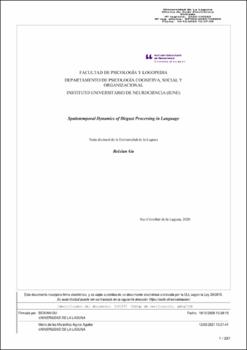Spatiotemporal Dynamics of Disgust Processing in Language
Autor
Gu, BeixianFecha
2021Resumen
A word’s emotional connotation is an important component of its meaning and function in daily communication. The present thesis goes beyond the general contrast between positive and negative valence stimuli, providing more detailed evidence on how emotional connotations within the same valence affect word processing; to this aim, the thesis chose disgust as the emotion of interest and in some experiments established sadness, another negative emotion, as a contrast condition. This thesis consists of three experiments. The first experiment investigated the electrophysiological signatures associated with the processing of disgust-related words to test a neural embodiment hypothesis. In addition, the experiment was conducted using Mandarin, a language different from Indo-European languages in a series of features. The second experiment explored the acquisition of words’ connotations of disgust or sadness using an associative learning paradigm to find out which of these materials is more efficient to induce emotional meaning in novel words. Finally, the third experiment also used an associative learning paradigm to examine how acquired disgusting or sad connotations of new words differentially affect electrophysiological activity, again to test the neural embodiment of the semantics of emotions. Based on the experimental results, it was concluded that firstly, the processing of emotional words in Mandarin elicited ERP signatures associated with disgust-related meaning (EPN and P2), which indicates early attention to disgust-related words. Also, late components (N400 and LPC) elicited by disgust-related words suggested a facilitation effect of lexico-semantic processes. Secondly, the processing of disgust-related words in Mandarin also confirmed the neural embodiment hypothesis as the main neural source of the early time window effects (EPN and P2) was the anterior insula, which has been associated in the literature with the processing of disgust in various modalities of stimuli. Thirdly, it has been found using the associative learning paradigm that facial expressions are more effective than emotional sentences as associative contexts in inducing connotations of disgust in new words. Fourthly, the processing of new words whose disgust connotation is acquired through faces in the associative learning paradigm elicited larger EPN amplitudes than those whose acquired connotations are sadness. Meanwhile, no difference was shown between new words’ acquired disgusting connotations and neutral connotations during the EPN time window. However, the two modulated the LPC component differently where new words’ acquired neutral connotations elicited larger LPC amplitudes than disgusting connotations. Finally and most importantly, increased activation in the anterior insula was found for disgusting new words compared to sad new words during the EPN time window while sad new words induced more activation in the anterior cingulate cortex than disgusting new words, which indicated that the processing of such acquired emotional connotations is embodied.





